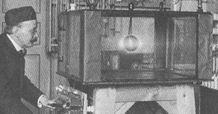#26H. Polar Cap -- History
|
The aurora is only seen in polar or near-polar regions. Why? Starting about
1895, the physicist Kristian Birkeland, in Norway, tried to answer this question experimentally.
|
| In a glass tank he put a small spherical magnet that modeled the Earth, and like William Gilbert before him, he named it terrella, the "little Earth." Elsewhere in the tank he mounted an "electron gun" like the one found in TV picture tubes--a hot wire emitting electrons, and plates charged to positive voltages to pull them out and speed them on their way. | 
|
|
Birkeland believed that auroral electrons came from the Sun, and the electron gun, aimed at the terrella, represented that source. The air in the tank was then pumped out (as well as one could do so 100 years ago) and Birkeland was gratified to see that the electron beam indeed converged towards the polar regions of the terrella and avoided the equator. There remained one puzzle. Polar explorers had reported that the aurora was extremely rare near the magnetic poles themselves. Why? A few of Birkeland's experiments indeed produced a ring of light with a dark center, but in general he only got a polar patch of light, covering the magnetic poles of the terrella. Birkeland's younger friend, the mathematician Carl Stoermer, analyzed the motion of the electrons mathematically and even computed many of their orbits, a tough task in the pre-computer days around 1907-10. He found no compelling reason why electrons entering the field from far away would avoid the poles. Stoermer died in 1957, still frustrated by this problem. The answer only came when satellites began probing the distant magnetosphere. They showed conclusively that the aurora did not in general come from the Sun or from distant space, but originated in the Earth's own magnetosphere. On the other hand, the electrons of the polar rain (see files linked to the bottom of this page), which apparently did come from the Sun, were indeed found in patches surrounding the magnetic poles, exactly like the patches of light Birkeland observed on his terrella.
|
Further reading:
"A Brief History of Magnetospheric Physics before the Spaceflight Era," Reviews of Geophysics, 27, 103-114, 1989.
"Exploration" home page (index)
Back to the Master List
Author and Curator: Dr. David P. Stern
Mail to Dr.Stern: earthmag("at" symbol)phy6.org
Last updated 25 November 2001
